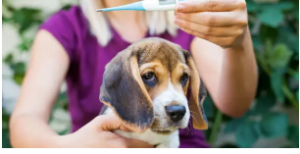How to Take Dog’s Temperature
Knowing how to take your dog’s temperature is essential for any pet owner. It can help you to identify potential health problems early on when they are most treatable.
Why is it important to take your dog’s temperature?
A dog’s average temperature ranges from 100.5 to 102.5 degrees Fahrenheit. A temperature above 103 degrees Fahrenheit is considered a fever, and a temperature below 98.6 degrees Fahrenheit is considered hypothermia. Fever and hypothermia can be severe, so it is essential to seek veterinary attention if your dog’s temperature is outside the normal range.
What are the signs that my dog may have a fever?
Some of the signs that your dog may have a fever include:
- Warm, dry nose
- Lethargy
- Loss of appetite
- Increased thirst
- Shivering
- Rapid breathing
- Vocalizing
- Red gums
- Diarrhea
- Vomiting
How do I take my dog’s temperature?
There are two main ways to take a dog’s temperature: rectally and orally. Rectal temperatures are more accurate, but oral temperatures are easier to handle.
To take a rectal temperature:
- Use a digital thermometer that is specifically designed for animals.
- Lubricate the tip of the thermometer with petroleum jelly or baby oil.
- Gently insert the thermometer into the dog’s rectum, about 1 inch deep.
- Hold the thermometer until it beeps (usually about 30 seconds).
- Remove the thermometer and read the temperature.
To take an oral temperature:
- Use a digital thermometer that is specifically designed for animals.
- Place the thermometer under the dog’s tongue and hold it until it beeps (usually about 30 seconds).
- Remove the thermometer and read the temperature.
Tips for taking your dog’s temperature:
- If your dog is resisting, have someone help you to hold them still.
- Be gentle and patient.
- Do not force the thermometer into the dog’s rectum or mouth.
- If you have trouble getting an accurate reading, stop and try again later.
What should I do if my dog has a fever?
Contact your veterinarian immediately if your dog’s temperature is above 103 degrees Fahrenheit. A fever can signify a severe infection or other medical condition.
What should I do if my dog has hypothermia?
Contact your veterinarian immediately if your dog’s temperature is below 98.6 degrees Fahrenheit. Hypothermia can be a life-threatening condition.
Conclusion
Taking your dog’s temperature is an essential skill for any pet owner. It can help you to identify potential health problems early on when they are most treatable. If you are having trouble taking your dog’s temperature or are concerned about their temperature, please consult with your veterinarian.
Additional information:
- If you are rectifying your dog’s temperature, lubricate the thermometer’s tip with petroleum jelly or baby oil. This will help to prevent discomfort and make the process easier for your dog.
- If you take your dog’s temperature orally, place the thermometer under the dog’s tongue and hold it until it beeps. Do not force the thermometer into the dog’s mouth.
- If your dog is resisting, have someone help you to hold them still. Be gentle and patient.
- Do not force the thermometer into the dog’s rectum or mouth. If you have trouble getting an accurate reading, stop and try again later.
- Contact your veterinarian immediately if your dog’s temperature is above 103 degrees Fahrenheit. A fever can signify a severe infection or other medical condition.
- Contact your veterinarian immediately if your dog’s temperature is below 98.6 degrees Fahrenheit. Hypothermia can be a life-threatening condition.
How to prevent your dog from getting sick:
- Keep your dog’s vaccinations up to date.
- Feed your dog a high-quality diet.
- Groom your dog regularly to remove any parasites or debris.
- Take your dog for regular veterinary checkups.
By following these tips, you can help to keep your dog healthy and happy.



